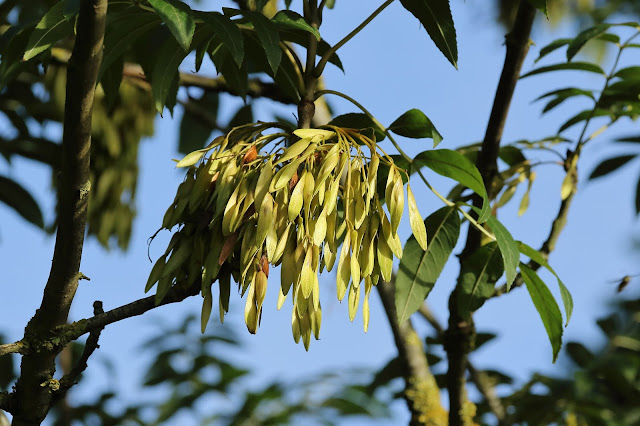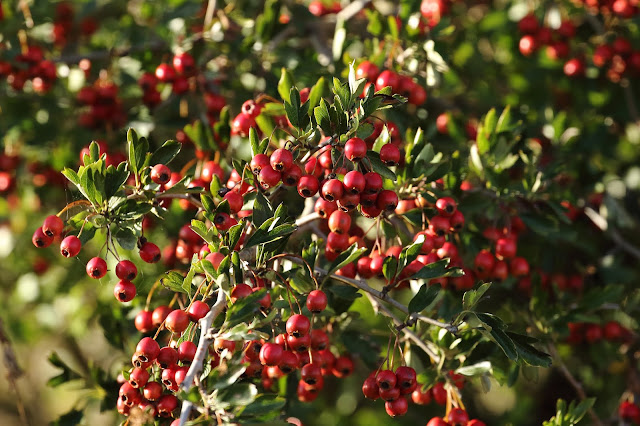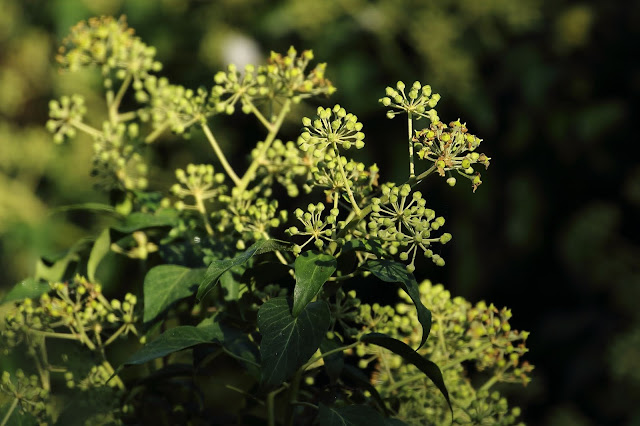August 2020
Amphibians and Reptiles
Common Frog – Adults and young frogs
were seen early in the month leaving ponds for terrestrial habitats. A very
small froglet was observed in West Field LA, some distance from any known
water, and a large adult and young frog were seen leaping across the lawn from
a pond on South Road, GA, both in the first week in August.
Common Toad – no sightings.
Smooth (or Common) Newt
– very
young newt-lets (almost transparent) caught in net while pond dipping in a pond
on South Road, (20th).
Grass
Snake – late in the month (21st) two snakes were
found together under an old paving stone in undergrowth in a garden on South
Road GA. Both were very slender, one 40 cm long, the other c. 25 cm long.
Possibly preying on young froglets that have recently left the garden pond. Another
snake (possibly the same 40 cm long one) seen in the same place on the 24th
together with a sloughed skin.
Birds
A quieter month for
birds, with adults and juveniles of many species foraging quietly in the
hedgerows. Some species starting to gather in flocks ahead of autumn, and
coming back to garden feeders – particularly Finch and Tit
species. Robin now commonly heard
singing again, setting up their winter territories, and House Sparrow more
evident again around their colonies.
Bittern – an exciting sighting
of this rare species, normally confined to large reedbeds, but some birds prone
to ‘wandering’ around the local area after breeding. Single bird seen in the
river by the recreation ground, before flying upstream over the ford (8th). A ‘first report’ for the Abingtons.
Common Sandpiper – single bird on migration,
seen feeding for a few days around GP lake (~20th).
Peregrine – brief sighting of a
single bird, hunting along hedgerows at south end of LSA (20th).
Summer visitors: Spotted Flycatcher –
a welcome sighting of this species, seen on 13th and 18th
in a Cambridge Road garden. Presumably a
bird passing through after breeding, these are the only reports of this species
in the parish this year.
Swift – two reports of 2-3
birds, presumably passing through – last on 8th. Swallow – frequent
reports of 1-4 from several sites until 20th. House Martin – frequently seen, flocks 10-12
over High Street GA, and returning to nests on the school (13th), also
around the lake on GP.
Warblers - several species still
around this month, but more silent and hidden. Blackcap – three reports
early in month of 1-2 birds, including juveniles along ORC. Chiffchaff –
more regularly along ORC, and one drinking from a garden pool on LSA. Common
Whitethroat – several reports on ORC and LSA until 18th, and Lesser
Whitethroat – one seen on ORC (7th).
Long-tailed Tit – returning to gardens
after a period of absence, 6-10 seen on South Road. Blue Tit and Great
Tit – small groups of 4-6 frequently with juveniles on several feeders. Coal
Tit – 2-3 also on feeders in South Road garden.
Greenfinch – small flocks of 6-8 returning
to some feeders, as are Goldfinch – 8-12 adults and juveniles. Bullfinch
– 1-2 regularly visiting running water near pond on South Road, as well as a
pair along ORC.
Goldcrest – 1-2 heard calling whilst
feeding in conifers on LSA, and one bathing in birdbath on LSA.
Buzzard – two over Sluice Wood,
also an adult and juvenile regularly over LA and ORC. Kestrel – two reports,
from GP and LSA. Sparrowhawk – one hunting around feeders in GA gardens.
Grey Wagtail – one along river near
Millennium Bridge. Pied Wagtail – flocks of c30 adults and juveniles feeding
on GP cricket green; 1-2 birds also reported on ORC and LSA.
Great Spotted
Woodpecker
– regular visitor to garden feeder on South Road, also occasional reports from
GP, LSA and GA garden. Green Woodpecker – reports of one bird near Millennium
Bridge, and on GP and LSA. Nuthatch – occasional visitor to High Street
LA feeder, often with mixed species Tit flock, and also one on garden feeder on Cambridge Road.
Song Thrush – single bird seen
regularly on ORC, but no longer singing.
Mistle Thrush – one in Sluice Wood early in month (7th).
Yellowhammer and Linnet – small
flocks (4-6) feeding along hedgerows on Roman Road and ORC.
Mute Swan – two flying over LSA,
heading towards GP (27th). Barnacle Goose – 6 on GP cricket green,
and Canada Goose – 8 adult and juveniles on GP lake. Mallard –
c20 in various stages of moult, 4 Moorhen and up to three Grey Heron
around GP lake.
Great Black Backed Gull
– small
loose flocks seen ‘roaming’ especially over recently harvested fields, often
including a few Herring Gull and Black-headed Gull.
Butterflies, Bees
and other insects
August was a
disappointing month for invertebrates, especially butterflies, with 213 reports
in total. The weather in August was very
variable with a few hot days, a few very cold days and nights, and a great deal
of rain and strong winds
The reports are from
within the boundaries of Great and Little Abington parishes, including a few
from Granta Park. Note that the numbers
given below are the number of reports of a species (not the number of
butterflies).
Butterflies (19 species, 181
reports). Butterfly reports for July
were dominated by Meadow Brown, Red Admiral, Comma and the
‘Whites’. Two possible sightings of Painted Lady.
Butterfly species
|
Reports
|
Butterfly species
|
Reports
|
Small White
|
31
|
Small Heath
|
5
|
Red Admiral
|
26
|
Small Tortoiseshell
|
4
|
Meadow Brown
|
21
|
Common Blue
|
3
|
Comma
|
20
|
Essex Skipper
|
2
|
Large White
|
17
|
Holly Blue
|
2
|
Gatekeeper
|
12
|
Large Skipper
|
2
|
Brimstone
|
11
|
Painted Lady
|
2
|
Green-veined White
|
8
|
Brown Argus
|
1
|
Speckled Wood
|
7
|
Chalkhill Blue
|
1
|
Peacock
|
6
|
|
|
Bees (11 reports); Moths
(6 reports); Dragonflies (13 reports); Ladybirds (2 reports)
Mammals
Bats – several bats still
flying regularly around a Bourn Bridge Road garden, and in Cambridge Road.
Fallow Deer – four spotted on ORC
on the 12th and another two on the 20th.
Field Vole - a continued presence
in a Cambridge Road garden.
Grey Squirrel – a continued presence
in a Cambridge Road garden, and also in Bourn Bridge Road.
Hare – two on 9th
in Granta Park and another two on the 29th along the ORC.
Muntjac - one regularly in
Cambridge Road.
Rabbit – one spotted in
Cambridge Road.
Flora
Flora species reported in flower this month:
Common Knapweed, Common
Restharrow, Spear Thistle, Dwarf Thistle, Goat’s Beard, Lady’s Bedstraw,
Bladder Campion, Yarrow, Wild Basil, Common Mallow, Small Scabious, Field
Scabious, Mugwort, Ragwort, Common Mallow, Golden Rod, Dark Mullein, Common St
John’s Wort, Common Storksbill, Marjoram, Wild Strawberry, Rosebay Willowherb, Himalayan Balsam
Rivercare
After a long break, river sampling was restarted on 11th August,
but with reduced numbers of people due to COVID. The river level was low, and the
water quality was much as usual, high in nitrates but minimal phosphate. We
were a little alarmed to find the usual weed was missing, and reported
disappointing results, with no fly larvae, or indeed much else, apart from three
different fish: Minnow, Stone Loach and Miller's Thumb. The detailed report can be found here.
Several clumps of Himalayan Balsam reported and removed.
Weather
The rainfall for August
was a respectable 93 mm. The highest temperature was 39.5 C on the 12th,
with 7 days of temperatures of over 30 C! The lowest temp was 5.6 C on the 31st.
Generally a calm month but with a couple of windy spells towards the end.
Many thanks to all those who contributed reports of their
sightings for August 2020:
Peter
Brunning, Lois Bull, Anne Dunbar-Nobes, David Farrant, Gaynor Farrant, Jennifer
Hirsh, Len Mead, Andy Merryweather, Polly Merryweather, David Pimblett, Gill
Smith, Derek Turnidge, Sally Turnidge.
Please email your sightings, within the Abington parishes,
to the relevant ANW Recorder:
Amphibians
and reptiles: Anne Dunbar Nobes ac.dunbar.nobes@gmail.com
Birds: Derek
Turnidge derek@turnidges.com
Butterflies, Bees etc: Jennifer Hirsh jennifer@hirsh.com
Mammals: Gill
Smith richardandgill.smith@live.co.uk
Flora: Currently vacant - if
interested, please contact David Farrant for more details.
Abbreviations:
GA – Great Abington, LA – Little Abington, LSA – Land Settlement Association,
GP – Granta Park, ORC – Old Railway Cutting.



































